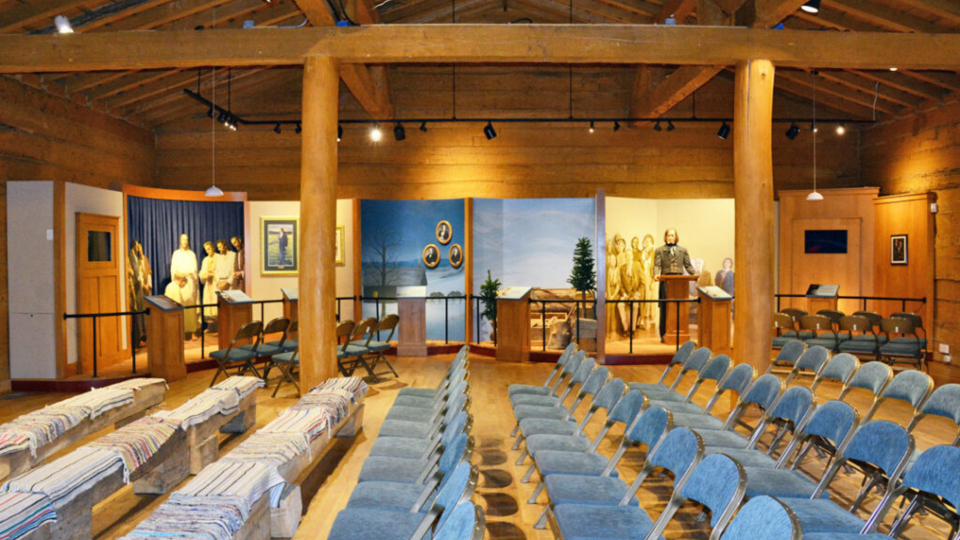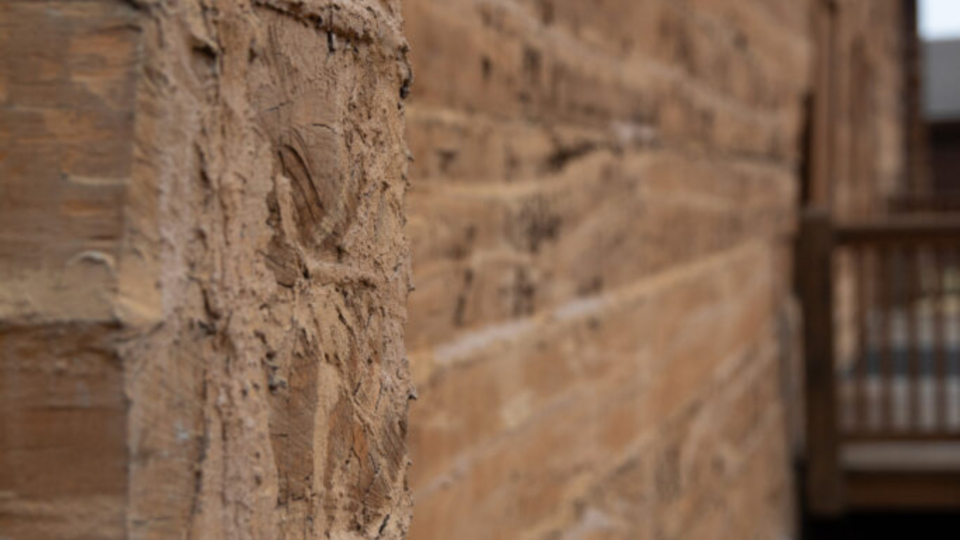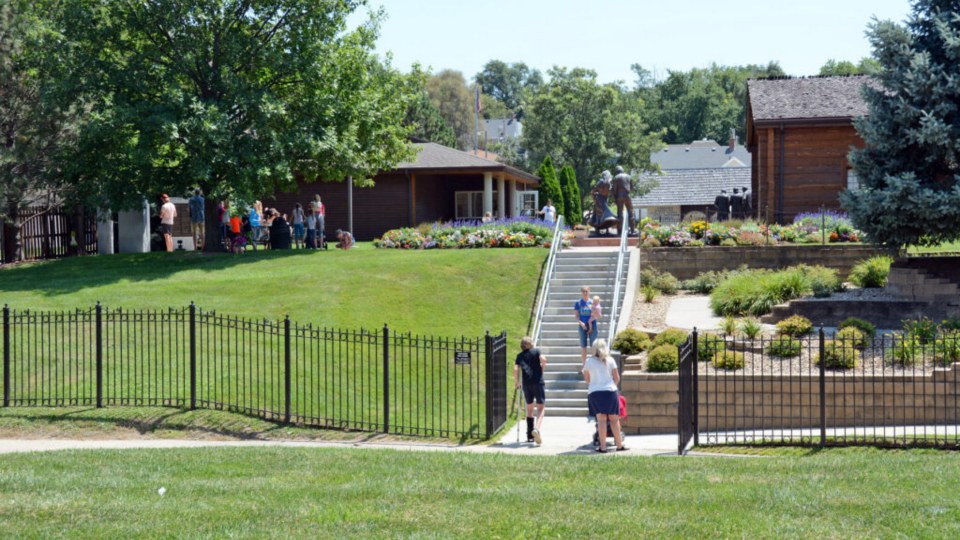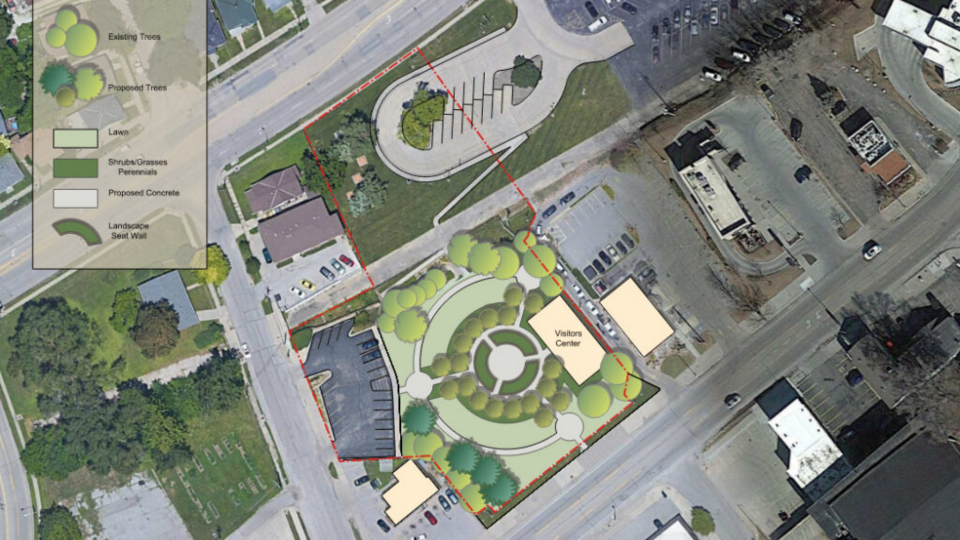- Kanesville
- Kanesville
- Kanesville
- Kanesville
- Kanesville
- Kanesville
- Kanesville
- Kanesville
- Kanesville
- Kanesville
| Temple Square is always beautiful in the springtime. Gardeners work to prepare the ground for General Conference. © 2012 Intellectual Reserve, Inc. All rights reserved. | 1 / 2 |
This story appears here courtesy of TheChurchNews.com. It is not for use by other media.
By Christine Rappleye, Church News
The Kanesville Tabernacle was built in three weeks to have a space large enough for a conference for the displaced pioneers to sustain Brigham Young as Church president in December 1847 in the area of Council Bluffs, Iowa.
“It was rough-hewn. It was hastily built. It wasn’t built to last forever,” said President Richard L. Bennett, previously a professor of Church history and doctrine at Brigham Young University and who is leading the Mormon Trail Center at Winter Quarters with his wife, Sister Patricia Bennett. “But what happened there would have a permanent impact on the history of the Church, in that Brigham Young is sustained as the next president of The Church of Jesus Christ of Latter-day Saints” during a solemn assembly on December 27, 1847.
The event 175 years ago is one of several significant events that happened in Kanesville, President Bennett said.
The Kanesville Tabernacle, one of the first tabernacles built by the Church, lasted a couple of years. It was rebuilt in the mid-1990s and dedicated in 1996 by President Gordon B. Hinckley.
“It was a wonderful effort … to remember and commemorate everything that happened in Council Bluffs,” said President Bennett. However, like the original, “it’s been gradually, continually decaying to the point of no return.”
The replica tabernacle, which could no longer safely accommodate visitors, is being dismantled and work began on April 4. And in its place will be walkways, landscaping with native shrubs and plants, sculptures and self-guided interpretive signs to share the Church’s history in the area, including the Saints settling along the Missouri River, the Mormon Battalion mustering and Oliver Cowdery’s return to the Church, said Jacob Olmstead, a historic sites curator for the Church History Department. The existing visitors’ center will remain.

Kanesville
Displays inside the Kanesville Tabernacle in Council Bluffs, Iowa, are shown in May 2017. Photo by Kenneth Mays, courtesy of Church News.All rights reserved.
2 Kanesville Tabernacles
It was 175 years ago in 1847 when Brigham Young and other leaders returned from their trek west with good news — they found the valley.
They wanted to get the news out to everyone and also re-establish a First Presidency, as Brigham Young had been serving as president of the Quorum of the Twelve Apostles since the death of Joseph Smith in June 1844.
When they first met in early December, “they didn’t have a place large enough for a conference,” President Bennett said.
Henry Miller, a master carpenter who founded the community, was asked to construct a tabernacle, with “about 200 others to join him in erecting it as quickly as possible,” Bennett said of the 60-foot by 40-foot structure.
During the next three weeks, they used the abundant, yet soft cottonwood timber to construct the Kanesville Tabernacle. Getting a harder wood would have taken longer, President Bennett said.

Kanesville
The visitors’ center in Council Bluff, Iowa, near the site of the Kanesville Tabernacle. 2022 by Intellectual Reserve, Inc. All rights reserved.Kanesville Tabernacle was the first tabernacle built, and others were also built in the area, including the Pigeon Creek Tabernacle and the Tennessee Hollow Tabernacle and a Welsh tabernacle, President Bennett said.
Due to flooding in the area that seeped into the building, the tabernacle was dismantled in 1849.
“The original tabernacle only lasted for two years, at best,” President Bennett said. “For a century and a half, there was no tabernacle there.”
In the mid-1990s, a group took the initiative to buy property near the original site and rebuild the Kanesville Tabernacle, using the same wood and the same width and length. President Gordon B. Hinckley dedicated the reconstructed tabernacle on June 13, 1996. The Church began managing it in 1999, Olmstead said.
President Bennett said, “It has fulfilled a marvelous purpose — in the lives of those who have consecrated to build it and those who have worked so hard to maintain that over the years.”
4 Notable Events in Kanesville
In addition to the solemn assembly, President Bennett and Olmstead pointed to notable events in Church history that happened in Kanesville.
“If you ask most Latter-day Saints about Winter Quarters, they could probably tell you something about that,” Olmstead said. “[What] Latter-day Saints don’t know so well is that maybe the more important element of history happened on the east side of the river.”
The mustering of the Mormon Battalion on July 16, 1846, was in Kanesville. (The 175th anniversary of the more than 500 men and women reaching San Diego, where the Mormon Battalion Historic Site is, was commemorated earlier this year.)
“One of the things we want to do at the site going forward is to remember the sacrifice of [the families who stayed behind] that had to require just as much faith, that the Saints would provide for them and that they would be taken care of on their journey west without their spouses and their husbands and fathers and brothers,” Olmstead said.
Kanesville was originally called Miller’s Hollow because of pioneer Henry Miller’s encampment. The name was changed to Kanesville after Thomas L. Kane, a military officer and attorney who worked on the Latter-day Saints’ behalf, including the formation of the Mormon Battalion.
“He wasn’t a member of the Church, but he was a great friend,” Sister Bennett said of Kane’s work with U.S. political leaders to help ease misunderstandings about the Church.
It was also in the Kanesville Tabernacle when Oliver Cowdery returned to the Church in November 1848. Oliver isn’t immediately recognized by those in attendance, Olmstead said. “Orson Hyde recognizes him and invites him to the stand.”
On several occasions, he shares “amazing eyewitness testimony of the things that he’s observed and participated in,” Olmstead said. Oliver’s experiences included those as one of the three witnesses to the Book of Mormon, as one of Joseph Smith’s scribes during its translation, and he was with Joseph Smith during the restoration of the priesthood.

Kanesville
Visitors walk around the Kanesville Tabernacle and visitors’ center in Council Bluff, Iowa, in 2018. Photo by Kenneth Mays, courtesy of Church News.All rights reserved.
History of Kanesville
When 12,000 early members of the Church left Nauvoo, Illinois, over several months in 1846, they headed west across Iowa, settling on both sides of the Missouri River. About 4,400 pioneers settled in Winter Quarters, Nebraska, on the west side of the river, with another 3,500 to 4,000 people on the Council Bluffs, Iowa, side of the river in a community called Miller’s Hollow, then Kanesville.
The rest fanned out about 50 to 100 miles up and down the Missouri River Valley on the Iowa side in some 81 settlements, President Bennett said. They settled “wherever there’s timber and water and pasture, wherever they can find a place to put in residence.”
After the first companies went west, Kanesville and Winter Quarters became a waystation and a launching point for pioneers heading west, Olmstead said.
And researchers are still finding more about the communities established by the early Church members.
“We’re continuing to discover more of the settlements of the Saints,” including a tabernacle site and gravesites, President Bennett said of the discoveries and work of local scholars and groups specializing in pioneer research.
“It’s a story that’s unfolding and it’s exciting to see that unfolding story,” President Bennett said.

Kanesville
The plans for the renovation of the Church historical site at Kanesville in Council Bluffs, Iowa. The tabernacle was scheduled to be dismantled on April 4, 2022. Work on the grounds will be July to November 2022 and the grounds are expected to reopen in early 2023. 2022 by Intellectual Reserve, Inc. All rights reserved.
How to Remember
The Church operates 24 historic sites that “tell significant, essential, key messages of the restoration and that are significant to an international church,” Olmstead said.
Although the tabernacle “has come to the end of its lifespan, those stories still need to be shared and honored,” Olmstead said.
Demolition began on April 4. The visitors’ center and paths around the area are scheduled to reopen on Monday, April 25. The project will begin in earnest from July to November, and the site will reopen in 2023. See the Kanesville Tabernacle Facebook page and the Church’s website for hours and closures. When it’s reopened, the visitors’ center will be staffed with missionaries.
Twelve miles from the Kanesville Tabernacle site, the Winter Quarters sites are open on the Omaha, Nebraska, side of the river, including new displays in the Mormon Trail Center and the pioneer cemetery that was beautified during the past year, President Bennett said. Virtual tours are also available of the Mormon Trail Center.
“There is a lot to see here at Winter Quarters, and then there’ll be a lot to see over in Kanesville,” President Bennett said. “Even though the tabernacle won’t be there, there will be a beautiful remembrance and tribute … that will bring to life a lot of the history.”
Copyright 2022 Deseret News Publishing Company.
